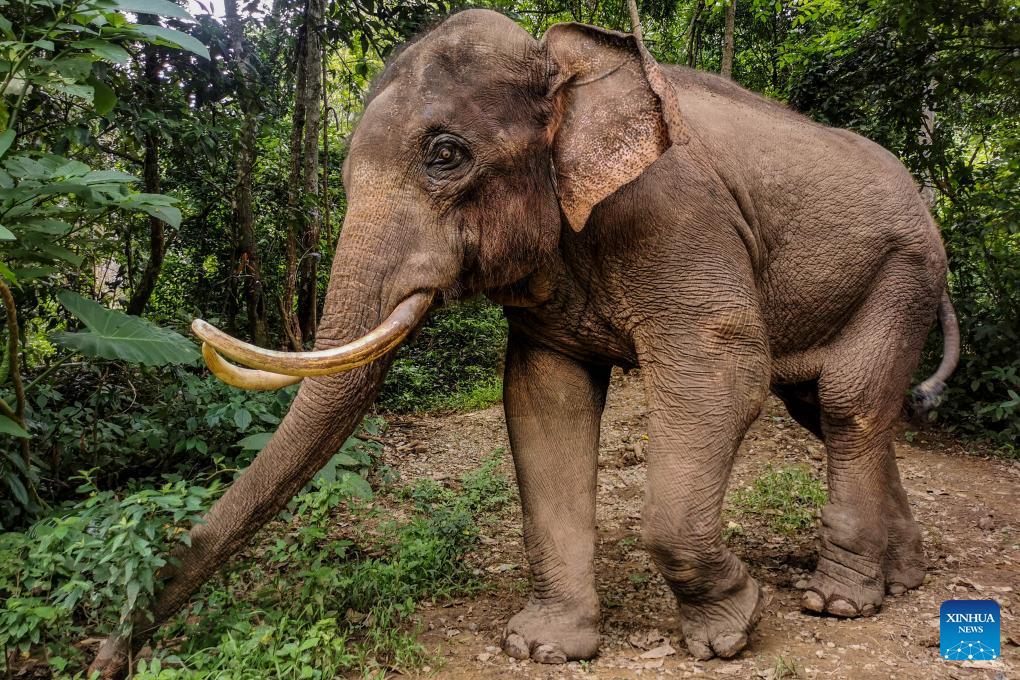
 0 Comment(s)
0 Comment(s) Print
Print E-mail Xinhua, August 13, 2024
E-mail Xinhua, August 13, 2024
This undated file photo shows elephant A Bao conducting adaptation training in Xishuangbanna Dai Autonomous Prefecture in southwest China's Yunnan Province. [Photo/Xinhua]
A Bao was once notorious in downtown Pu'er City in Yunnan Province. His antisocial antics even caused concern among local authorities. Today he lives alone deep in the dense forests of southwest China's Xishuangbanna. A Bao is happy, this is, after all, paradise for an elephant.
In May this year, A Bao, or "the treasure," was returned to the wild following years of meticulous training and preparations and, as China's first successful case of reintroducing rescued Asian elephants to nature.
Crossing human paths
It was back in 2018, when A Bao--then 12 years old and weighing 2.1 tonnes--became estranged from his herd and embarked on an urban adventure. His wanderings, across city streets, bus terminals, schools and street markets, saw local authorities frantically initiate emergency response plans in a bid to avoid human-elephant confrontation.
After an initial attempt to lure him away from the city failed to put A Bao off revisiting, he was sedated and transported to the Xishuangbanna Asian Elephant Rescuing and Breeding Center in Xishuangbanna Dai Autonomous Prefecture. To date, the center has been involved in the rescue of 30 wild Asian elephants.
Given elephants have an exceptional memory, A Bao's experience of wandering through cities and interacting with people meant there was a high risk of recidivism, said Bao Mingwei, a senior veterinarian at the center.
Despite his previous form, A Bao was identified as a good candidate to return to the wild, according to Bao, who believes that the healthy, toned elephant had acquired survival skills such as foraging and finding water sources from the elephant herd during his childhood.
To prepare A Bao, the center crafted a meticulous dietary and training plan. Chen Yubing was designated A Bao's breeder and "father."
Chen instructed A Bao with simple pronunciations of "Ma" and "Bai" which mean "come over" and "go away" in the Dai ethnic group's dialect. Over half a year later, the elephant could follow Chen to the riverside for a bath. However, the interactions between the two were always kept to a minimum for the sake of the ultimate goal.
Following assessment, researchers officially launched the pilot project of returning rescued Asian elephants to nature in July 2022, with A Bao as their case study.
Chen started to take A Bao out of the breeding center, and into the wilderness for adaptation training.
"The adaptation training lasts no less than 7 hours each day. I observe from a distance, trying not to intervene. A Bao will decide what time to go back 'home' after having a good time out in the rainforest," said Chen.
As the project progressed, A Bao stayed longer in the wild and consumed a greater variety of natural plants. His weight increased to 2.4 tonnes. After extensive discussions, elephant experts determined that A Bao met the final preparation requirements. He was ready to return to the wild.
Back to the wild
On April 14, A Bao embarked on his final-stage training in an independent wilderness area spanning over 200 mu (about 13.33 hectares).
"In the beginning it was two to three days between pick-ups, and later a week," said Chen. Though anxious about A Bao's wellbeing, Chen knew all too well that severing the elephant's ties with human beings was essential to the success of the final return.
When A Bao first went to the independent wilderness area, it seemed the elephant thought it would be like the previous daily training routine, waiting at the fence for Chen to pick it up around 4 to 5 p.m. every day.
"He was just like a child who goes to kindergarten every day and one day finds that his parents didn't come and pick him up," Chen said. He watched A Bao from a distant hill every day.
After a month of observation, researchers decided to release A Bao. At 6 p.m. May 17, the fence gate was opened, and A Bao lumbered out. "Bai, Bai," Chen could only whisper as he watched A Bao's retreating figure, hoping he would "keep going and not look back." A Bao vanished into the forests.
A Bao wears a collar that sends positioning data to a monitoring drone, so rangers know he mostly stays in the jungle. From an initial range of just a few kilometers, his current activity radius exceeds 20 kilometers, without any instances of entering villages. Moreover, he has made multiple attempts to integrate into an elephant herd consisting of 26 elephants.
"He looks stronger and more vigilant," said Bao Mingwei after watching the monitoring footage. Through fecal analysis, it was discovered that A Bao now eats over 100 types of food sources, the same as a wild adult elephant.
Researchers will continue to closely monitor A Bao, and based on his case study they will engineer a systematic, scientific and replicable routine for the reintroduction of Asian elephants to nature, said Wang Bin, director of the protection and management center of Asian elephants in Xishuangbanna.
"Our ultimate hope is for A Bao to successfully integrate into a wild elephant herd and have offspring of his own."